9th March 2012
A Good Explore Around Sydney and Walking the Coathanger

Chinatown
|
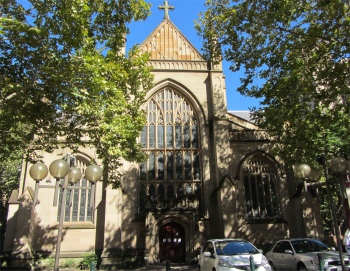
St Andrew's Cathedral
|
My body clock was still functioning in NZ time, and I awoke at 03:45. Dozing fitfully wasn't doing me any favours, so I was enjoying a refreshing shower at 06:30.
At breakfast, I was pleased to find the residents were a mixed bunch, not all young women. The Dutch couple I sat next to were off today. "We have had terrible rains over the last 2 weeks. Now we are leaving it is turning sunny," said the woman.
I had an itinerary in mind, which I couldn't cover in one day, so I set off at a leisurely pace to take in what I could today. The locality of the hotel was not littered with dead bodies, which was reassuring.
My starting point would be Chinatown via Paddy's Market. The latter was a large building with all manner of food, clothing and almost everything else. I had no intention of buying anything, but the spectacle of such markets is almost always colourful, as are the characters that run the food stalls.
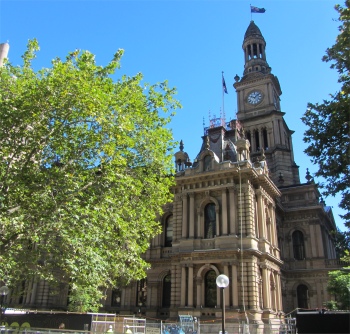
Town Hall
|
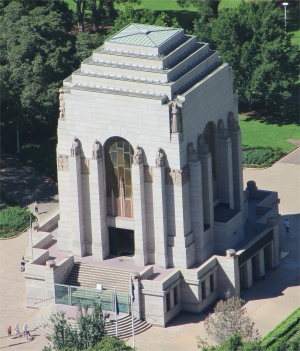
Anzac Memorial
|
In contrast, Chinatown during the daytime was not so colourful, but perhaps its cloak may become a mass of colour after dark.
I strolled past St Andrew's Cathedral. When Sydney was still the size of a village, Governor Macquarie conceived the idea of a cathedral, naming it after the patron saint of his native Scotland. The first stone of this oldest cathedral in the country was laid in 1819, and the late-Gothic cathedral was consecrated in 1868. Links with the motherland include a marble floor from Canterbury Cathedral and two stones from the Palace of Westminster.
Right next to the cathedral stood Sydney Town Hall. The sandstone architectures of these two buildings contrasted dramatically with the glass and steel monoliths surrounding them.
Sydney Tower was close at hand. A lift whisked me, and a group of others, to the golden turret of the Sydney Tower in 40 seconds, and we all poured out onto the observation deck offering 360� panoramic views. For a real buzz, the Skywalk permitted a walk on a glass-floored viewing platform 260m above city level - the height of the Eiffel Tower. Personally, I couldn't see the point, so I didn't skywalk. Until now, I hadn't really appreciated how much water there was around Sydney, it was a bit like Auckland in that respect. In the distance I could see planes landing and taking off at the airport, and in the far distance laid the Blue Mountains.
|
|
Looking Across to Milsons Point (please use scroll bar)
|
|
Looking Across to Darling Harbour (please use scroll bar)
|
|
Looking East Across to the Tasman Sea - The Domain and Hyde Park Below (please use scroll bar)
|
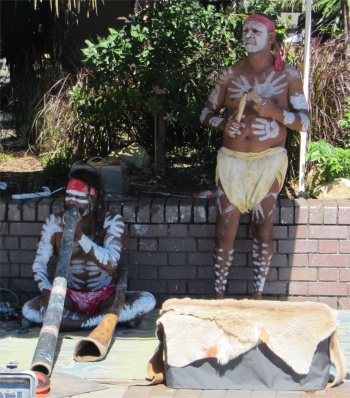
Aborigines at Circular Quay
|
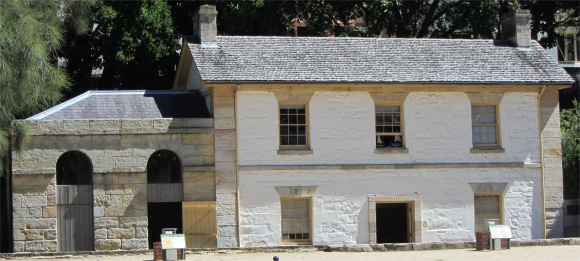
Cadman's Cottage
|
Once back on terra firma, I walked down the busy Pitt Street, all the way to the Overseas Passenger Terminal at Sydney Cove, where a large cruise ship was berthed. Apparently the evening before the Queen Mary had been tied up here. I didn't know she was into bondage. Here, the waterfront was buzzing with hundreds of tourists, all clicking away with their cameras. Numerous ferry boats scooted in and out of Circular Quay; this was certainly a hub of activity.
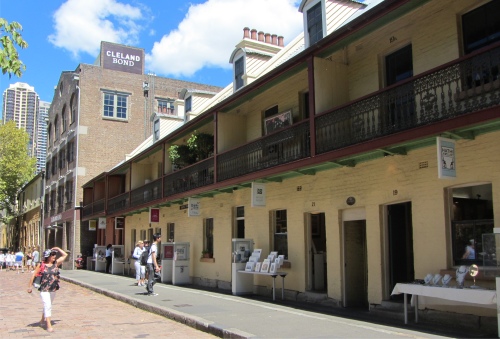
An Early Street in The Rocks
|
A couple of Aborigines hung out under an awning, covered in decorative paint, one playing a didgeridoo and the other clapping a pair of sticks together to produce a rhythm. Their melodic tunes were accompanied by a chorus of clicking cameras. It amused me watching the swarm of clicking cameras move from one focal point to another. The swarm usually consisted of complete villages of Japanese tourists, all yattering away in their native tongue whilst clicking furiously, like a swarm of overgrown, dressed up cicadas.
At one point, the swarm dispersed to move onto their next target. As they dispersed, Cadman's Cottage became visible, the oldest remaining building in Sydney. This building, the Coxswain's barracks, was built in 1816 at what was then the water's edge. The Coxswain ran the small fleet of official boats crewed by convicts, an important task when almost everything the colony used was brought by ship.
Cut into the natural rock shelf, the building originally had a small sandy beach to its front. The plain Georgian architecture was copied from English pattern books and it was part of a wider attempt to build "respectable" government buildings for the new
The first Coxswain was Bernard Williams, followed by David Smith, John Weiss and finally John Cadman. Cadman had been sentenced to death in England for stealing a horse, but the need to colonise Australia at the time saved him from the gallows, and he was deported for life instead. Cadman, who had worked in dockyards in the motherland, had gained his freedom, and was appointed as Coxswain in 1827, and lived at the barracks for 19 years. The building eventually became known as Cadman's Cottage.
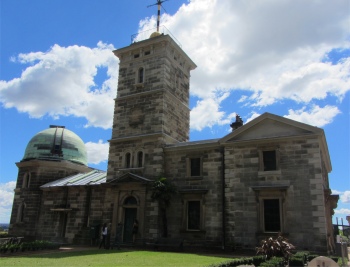
Sydney Observatory
|
I gained height behind the cottage and visited the Rocks district. Sydney was first settled by the British as a penal colony on January 26 1788 when 400 settlers and 750 convicts arrived on the First Fleet of 11 ships. The convicts had been sentenced to transportation for crimes as minor as stealing food, though there were hardened criminals among them. More convicts arrived from England, and later Ireland. These and the soldiers sent to guard them were settled in the area named "The Rocks". They built huts of unseasoned timber or mud reinforced with twigs from trees.
Convicts were put to work under the harshest conditions to erect public buildings and homes for government officials and free settlers. Substantial early structures were built of hand-made bricks or blocks of sandstone. At the Argyle Cut, convicts had been forced to try to cut through rock by hand to make a road. This proved to be an impossible task for construction with hand tools, and it was eventually completed by non-convict labour using explosives.
The Rocks has the biggest concentration of historic buildings in Sydney. Most have been "recycled" and house shops, restaurants, art galleries, and the like. Some terrace houses (strings of two and three storey houses built side-by-side and sharing common dividing walls) survived and are now much sought after as places to live. The area is dotted with pubs, including the Lord Nelson which has traded since 1842, and the Hero of Waterloo since 1845. The Hero was once notorious as a place where men were made drunk and dragged off by press gangs through a tunnel, which ran under the hotel, to a house across the street from where they were taken to the nearby wharves.
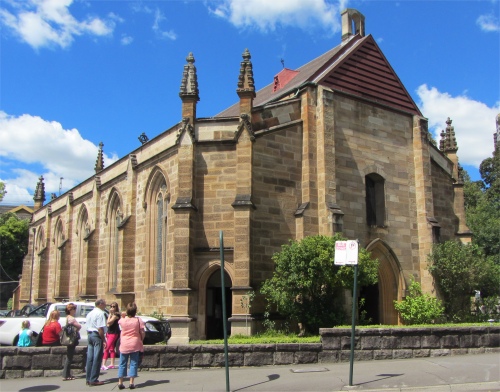
Garrison Church
|
As I walked up the Argyle Cut, I entered a courtyard of one of these "recycled" buildings. The tables of diners were surrounded by high walls with windows covered by solid looking steel bars. "Was this a prison of sorts?" I asked a guy standing next to me. The Australian replied, "No mate, I think they might have kept wool here before it was loaded onto ships and sent overseas." I then spotted the tell-tale signs of warehouse loading hatches climbing vertically up one corner of the building, and we agreed together that it had been a warehouse at one time. "I would love to come to your country to see all the history," the Australian guy said. We chatted some more, and as we parted, he wished me, "Good luck with your travels, cobber." Being called a "cobber" was a first for me, and I now started to feel I was in Australia.
The Garrison Church, at the top of Argyle Cut, was consecrated in 1844 and is still in use. The Garrison Historical and Military Museum next to the church traces the history of the English soldiers sent to control the convicts, frequently with great brutality. Sent to serve in the farthest corner of the British Empire as little more than prison guards with little reward and no glory, many of the soldiers were worse than the convicts under their control.
Today, The Rocks is one of the most-visited parts of Sydney. It is not hard to see why. Nestled at the foot of the Sydney Harbour Bridge and on the western shores of Sydney Cove, it is the foundation place of Sydney and Australia, and of enormous historical significance. The area is often described as "Sydney's outdoors museum". The Rocks redevelopment has had its share of controversy. During the 60s there was a tumultuous period of community opposition to the then government's urban policies based around massive modern high-rise redevelopment plans. Pickets had positioned themselves around proposed redevelopment sites like the Rocks, effectively saving them from demolition. This oldest area of Sydney has recently undergone an amazing metamorphosis, the old district being transformed into a vibrant pocket of cafes and restaurants and interesting tourist shops and stalls. This has been achieved without destroying the area's Old World charm and historic buildings. Today planning is controlled by a quasi-government authority which manages the area, and Sydney's town planners put in place a sensitive conservation program that has preserved the heritage and character of The Rocks and brought about an interesting fusion of modern amenities in an old and valued setting.
|
|
Looking East From Sydney Harbour Bridge Towards Sydney Opera House and Circular Quay (please use scroll bar)
|
Overlooking the Rocks, and everywhere else for that matter, stood the original Sydney Observatory. Built in 1858, and standing on Observatory Hill, it is the highest natural point in the city. It still has its optical astronomical telescope which was once a key to the scientific study of astronomy in the Southern Hemisphere, and it also has a time ball which acted as a reference point for ships to set their clocks to. The Observatory is now a museum by day, but still conducts occasional explorations of the sky by night. The park around the observatory offers an almost 360� panoramic view of Sydney Harbour, which stretches from Darling Harbour to the historic and now "trendy" inner western suburb of Balmain, up the Parramatta River, over the water to the Lower North Shore, over the Harbour Bridge, up the harbour to the east, and back to the city skyline.
The obvious thing to do on reaching this position in Sydney is to take a walk across the iconic bridge.
In the first half of the nineteenth century, Sydney was formed around Sydney Cove and later, as the population grew, it developed around the harbour and its tributaries to the north, west and south. European settlement on the northern side of the harbour began in earnest after 1814, following a land grant to ex-convict Billy Blue, who began the first ferry service across the harbour soon after. Proposals to join the north and south sides of the harbour with a bridge were first put forward in 1815 by another convict, architect Francis Greenway.
At the turn of the twentieth century, with advances in bridge engineering technology internationally, alongside developments in the local manufacture of prefabricated steel and reinforced concrete, the NSW Government began to seriously investigate the possibility of building a bridge across the harbour. The Sydney Harbour Bridge Act was passed and assented in 1922. Under the act, tenders were called to construct a bridge between Dawes and Milsons Point. Tenders were closed in 1924, the winning tenderer being the British engineering firm of Dorman, Long and Co.
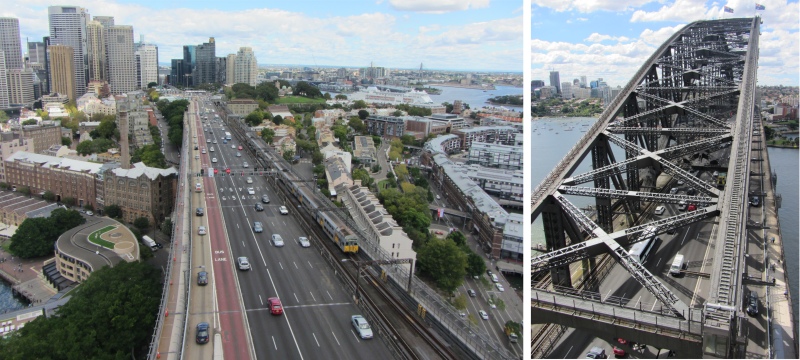
Traffic Entering and on the Coathanger
|
The Sydney Harbour Bridge, also affectionately known as the "Coathanger", was opened on March 19th 1932 by Premier Jack Lang, after eight years of construction. The opening ceremony was broadcast worldwide and was famously disrupted when Francis De Groot, a member of the fascist, anti-Lang New Guard, rode across the bridge on horseback and slashed the ribbon with a sword. After De Groot was taken away by the police, the ceremonial ribbon was held in place and Lang cut it, declaring the bridge open.
Sydney Harbour Bridge in its beautiful harbour location, has become a renowned international symbol of Australia. Its total length including approach spans is 1149 metres and its arch span is 503 metres. The top of the arch is 134 metres above sea level and the clearance for shipping under the deck is a spacious 49 metres. The 49 metre wide deck makes Sydney Harbour Bridge the widest longspan bridge in the world. It now carries eight vehicle lanes, two train lines, a footway and a cycleway.
I walked all the way across the bridge to Milsons Point, whilst half of Sydney flew past me in their jogging gear. Signs requested joggers to slow down on the bridge, but of course down under, everything is inverted, and these guys shot by on a mission. I ambled down to the harbour side at the far end of the bridge. It was good to get a view of the CBD from Milsons Point, to get a different perspective of the Sydney Opera House and to take in the dramatic skyline of the city (impossible to do when in the city).
On returning back to the southern side of the harbour, I skirted around the Circular Quay. Circular Quay, at the foot of the central business district and the older, historic end of the city, is the hub of Sydney Harbour. It is situated at a small inlet called Sydney Cove, the founding site for Sydney and Australia, and is a stepping-off point for most attractions based around the harbour; an exciting place to be on a warm summer's day. The quay is a vibrant, bustling place with the green and yellow ferries leaving every few minutes to different parts of the harbour, including Manly, Watsons Bay, Mosman and Taronga Park Zoo. From here I was afforded great views of the Harbour Bridge, a short distance away. On the southern side of Circular Quay is a walkway that leads to the Sydney Opera House and Royal Botanical Gardens; while on the northern side, a short walk along lovely landscaped walkways leads to the Harbour Bridge and The Rocks, one of the oldest, most attractive and interesting parts of Sydney. Small outdoor cafes bristled alongside the ferry terminals, and the whole area served as a magnet for buskers and street performers of every description.
Work must have finished for the weekend in the city. All the outside bars in this vicinity were humming with the noise of countless suited executives, greedily quaffing their beers and recounting humorous tales to their colleagues. Not only is the quay a jumping off point for commuter ferries, but a train station also has a stop here. The area was as crowded as a London mainline station during rush hour.
Strolling around to the opera house, my eyes were drawn to the endless flotillas of ferries and yachts plying their way across the harbour. I just adore watching a working port, it holds much more attraction for me than a bland view of an expanse of blue sea.
Opposite me stood the Sydney Harbour Bridge which I had just traversed, now seen in profile. Day and night processions of blue "ants" scramble to the top via the BridgeClimb, and I could spot three such parties as I gazed.
I turned about from my harbour view, and there in front of me, on a promontory in a heavenly harbour, stood the national landmark, Sydney Opera House, the city's most famous asset. This glittering gem with its sweeping white sails was a stunning masterpiece of late modern architecture and a graceful piece of urban sculpture, its patterned tiles glistening in the sunlight and invitingly aglow at night. It is admired internationally and proudly treasured by the people of Australia.
I was enthralled by the sight of this architectural marvel, but just as equally I was engrossed with its history. Prior to the Sydney Opera House, Sydney had no adequate dedicated music venue. Orchestral concerts were given in its Town Hall, and staging opera was almost impossible due to the lack of suitable stages. The post-war Labour government had given lip service to the concept of an opera house as part of its reconstruction and redevelopment programs. However, as is often the case, apart from occasional public announcements, nothing happened for years. Finally, in late 1954, the State Government of New South Wales, finding itself increasingly embarrassed by its own inaction, became involved in a moderately supportive manner. The Premier of the day, Joseph Cahill, was enthusiastic about the idea and it was he who set up the committee which got the project under way. He also set up an appeal fund to raise money for the building. When it became obvious that the fund would not even raise the $7 million the Opera House was first estimated to cost, Mr Cahill introduced the Opera House Lotteries.
|
|
Panoramic View from Milsons Point (please use scroll bar)
|
|
The committee set up by the Government selected the site for the building. Known as Bennelong Point, it was named after the first Aborigine to speak English, who was born on the site. Until this time, it was used as wharfing area and had a rather unsightly tram storage barn prominently occupying much of the site.
The history surrounding the design and construction of the building became as controversial as its design. In 1956 the New South Wales Government called an open-ended international design competition and appointed an independent jury. The competition brief provided broad specifications to attract the best design talent in the world; it did not specify design parameters and surprisingly did not set a cost limit. Although the competition was organised for the design of a performing arts complex, the misnomer "Opera House" caught on. The competition called for a structure that contained two theatres within it - a large hall for opera, ballet, and large scale symphony concerts capable of seating 3,000-3,500 people, and a smaller hall for drama, chamber music and recitals, capable of seating approximately 1,200 people. 233 different design entries were submitted from all over the world. Reputedly rescued from a pile of discarded submissions, the winning entry of relatively unknown 38-year-old Dane J�rn Utzon created great community interest. The NSW Government's decision to commission Utzon as the sole architect was unexpected, bold and visionary.
|
|
Panoramic View from Circular Quay (please use scroll bar)
|
Construction of the building commenced in March 1959 and proceeded in slow stages over the next fourteen years. At the time that construction was started, Utzon protested that he hadn't yet completed the designs for the structure, but anxious to show progress, the government stupidly insisted that construction get underway, and so it did! After extensive testing, he developed a design based on sets of interlocking vaulted "shells" which were each complex sections of a sphere. From 1964, the pre-cast rib vaults of the shells were erected. The construction of the roof brought together some of the world's best construction engineers and craftsmen who devised new and innovative techniques to deliver Utzon's vision. The whole was set upon a vast terraced platform and surrounded by terrace areas that function as pedestrian concourses. At least as much a problem as starting the construction prior to completing the revolutionary design, was the fact that the government itself changed the requirements for the building after construction had started. From my experience as an engineer, changing requirements under the dictate of management is usually a serious retrograde step. The original design called for two theatres. Under the behest of the Australian Broadcasting Commission (ABC), the government changed its mind and required the building to be altered and that four theatres now be incorporated into the design. Recently, some internal changes to the structure have enabled a fifth theatre to be created. Although Utzon had spectacular plans for the interiors of the building, he was unable to realise this part of his vision. The project was subject to many delays and cost over-runs, and (probably unfairly) Utzon was often blamed for these. A new government was elected in NSW in 1965, partly on the campaign promise to "do something" about the cost overruns with the design. The government withheld fee payments to Utzon and refused to agree to his design ideas and proposed construction methods. This pretty much forced Utzon to resign, which he did in February 1966 as Stage II was nearing completion. Utzon left the country at the end of April with his family, never to return to see his masterpiece again. Following Utzon's resignation, there were protests and marches through the streets of Sydney led by architect Harry Seidler, author Patrick White and others, who demanded that Utzon be reinstated. Instead the Government appointed a team of Australian architects to complete the building.
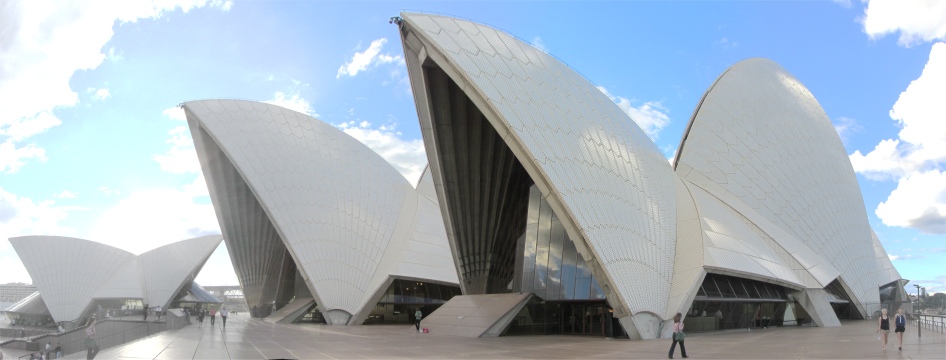
Sydney Opera House
|
When Sydney Opera House was opened by Queen Elizabeth II on 20 October, 1973, $102M had been spent on what was supposed to have been a $7M project. Utzon was not present at the opening ceremony. In 1998, Utzon was invited back to the project to resolve the resulting acoustic inadequacy of the interior. In addition the first alteration to the exterior of the building was the addition of a new Colonnade along the western side, which shades nine new large glass openings into the previously solid exterior wall. In 2003, the same year that Sydney Opera House celebrated its 30th birthday, J�rn Utzon was awarded the Pritzker Prize for Architecture, the highest award in its field. The Utzon-led restoration project, which was completed in 2006, gave the theatre foyers their first view of Sydney Harbour. The foyers' interiors are now being renovated to Utzon's specifications, to become a coherent attractive space for patrons. The design also incorporates the first public lift and interior escalators to assist less mobile patrons.
Sydney Opera House was inscribed in the World Heritage List in June 2007: "Sydney Opera House is a great architectural work of the 20th century. It represents multiple strands of creativity, both in architectural form and structural design, a great urban sculpture carefully set in a remarkable waterscape and a world famous iconic building." J�rn Utzon died in Copenhagen in November 2008 aged 90.
I had totally enjoyed my first proper immersion into this colourful, vibrant city with its unique history.
|
Uploaded from Sydney Airport on 15th March at 13:25
Last updated 15.3.2012
|

















